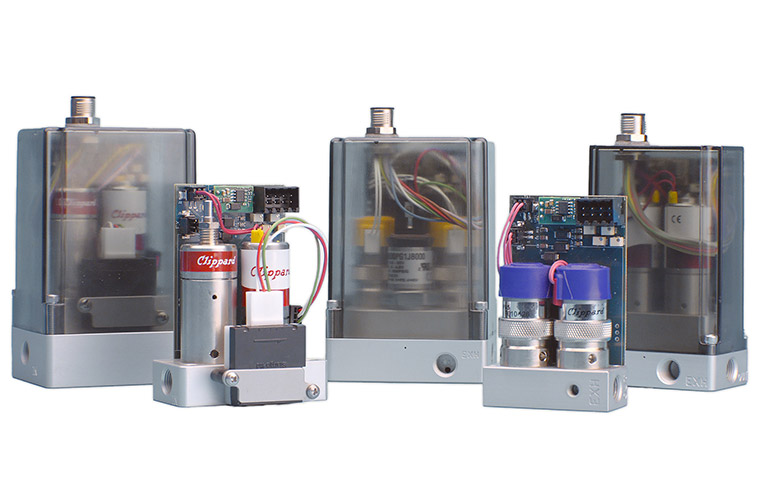In the realm of fluid power engineering and manufacturing, innovation knows no bounds. The advent of miniature pneumatics has ushered in a new era of precision and efficiency, enabling a wide range of industries to benefit from compact and surprisingly powerful pneumatic systems. These miniaturized marvels have found their way into various sectors, using low to medium pressure and serving as the backbone for countless light- and medium-duty applications.

Image courtesy Clippard
Miniature pneumatics refers to the design, development, and application of pneumatic systems at a significantly reduced scale compared to traditional pneumatic systems. These systems utilize compressed air or gases to generate force, motion, or pressure in a precise and controlled manner. With advancements in manufacturing techniques and high-quality materials, miniature pneumatic components have become more reliable, compact, and cost-effective than ever before.
The medical industry dramatically benefits from miniature pneumatics due to the need for precise control and compact, quiet devices. Applications range from surgical instruments, drug delivery systems, and prosthetics to respiratory devices, diagnostic equipment, and laboratory automation. Miniature pneumatic systems ensure accuracy, responsiveness, and safety, making them indispensable in critical healthcare settings.
Because of the ingenuity of engineers, methods to reduce power consumption (such as magnetically latched solenoid valves) provided medical equipment manufacturers with compact and portable devices not previously possible. Portable oxygen delivery systems are now small, portable and quiet, so patients are no longer bed-ridden when requiring oxygen supplementation. Many battery-powered pneumatic devices aid emergency workers as well as long-term care workers. Portable ventilators, nebulizers, and suction devices are just a few life-saving machines created from low-power, miniature pneumatic components.
Miniature pneumatics also play a crucial role in robotics and automation, where size, weight, and efficiency are paramount. These components enable precise movement, gripping, and actuation in small robotic systems, such as drones, industrial automation, and robotic prosthetics. Their ability to deliver high force and rapid response makes them invaluable in achieving delicate yet dynamic tasks.
The electronics industry demands precision and reliability in manufacturing processes, and miniature pneumatics rise to the occasion. They are used in pick-and-place machines, micro-electro-mechanical systems (MEMS), and semiconductor fabrication equipment. Miniature pneumatic components enable precise handling, positioning, and inspection of delicate electronic components, ensuring high-quality production with reduced risk of damage.
The aerospace and defense sectors benefit from miniature pneumatics in various applications, including flight control systems, unmanned aerial vehicles (UAVs), missile guidance systems, and parachute release mechanisms. Miniature pneumatic components offer rapid response times, compact designs, and the ability to operate in extreme environments, making them ideal for critical aerospace and defense operations.
Nearly every heavy-duty pneumatic component has a miniature counterpart:
Miniature valves control the flow of compressed air or gases in pneumatic systems. They come in various configurations, including solenoid, check, proportional, and shuttle valves. These valves provide precise regulation and quick response times, crucial for miniature applications where space is limited. Many miniature components come available as cartridge valves, allowing machine manufacturers to create custom compact manifolds to reduce plumbing or insert the valves into custom actuators as well.
Miniature cylinders convert compressed air or gases into linear motion, enabling actuation and movement in confined spaces. They are available in different types, including single-acting, double-acting, rotary, and compact cylinders. Miniature cylinders offer high force-to-size ratios and exceptional precision for controlled motion applications.
Miniature air motors offer high-speed, precise control for rotary applications, such as dental tools or medical saws. Conversely, tiny air motors used to accurately control liquid dosing systems or sample manipulation equipment turn very slowly and take advantage of extremely quiet and smooth operation.
Miniature air preparation units ensure the quality and cleanliness of the compressed air supplied to miniature pneumatic systems. These units consist of filters, regulators, lubricators, and pressure gauges. By removing impurities and regulating air pressure, miniature air preparation units enhance the performance and longevity of miniature pneumatic components.
Miniature fittings and tubing are required for miniature valves and actuators. They require appropriately sized plumbing, so miniature fittings and tubing provide the necessary connections and pathways for the flow of compressed air or gases. Depending on the application and work environment, they come in various materials, such as stainless steel and polymer.
Filed Under: Components Oil Coolers, Engineering Basics, Pneumatic Tips, Valves & Manifolds